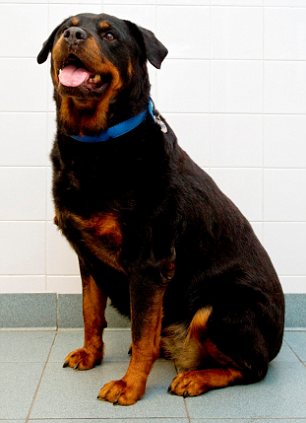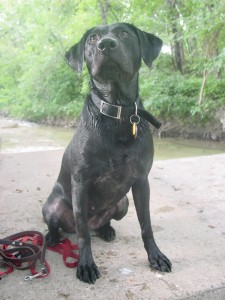© 2012 Jerry D. Patillo, CPDT-KA
 Many of us dog-friendly trainers use a lot of treats to introduce new behaviors to your dog. Many of you dog owners now have fat dogs. What’s gone wrong? Either we trainers have not communicated to you the proper use of treats and/or you have been overindulging your dog.
Many of us dog-friendly trainers use a lot of treats to introduce new behaviors to your dog. Many of you dog owners now have fat dogs. What’s gone wrong? Either we trainers have not communicated to you the proper use of treats and/or you have been overindulging your dog.
The reason we food-trainers like food or treats so much is because most of your dogs respond so well to this type of training. Put a delicious treat in front of your dog’s nose, bring the treat over the dog’s eyebrows, and voilà! Your dog raises its head toward your treat and puts its butt on the floor. (At least, that’s what it says in MY training manual!) It’s as rewarding for us humans as it is for the dogs.
Here’s the catch: We use the treat as a bribe in the beginning to INTRODUCE a new behavior. Once we’ve got the behavior that we want, then we MUST change ourselves from Bribe Machine to Slot Machine. We need to keep our dog guessing: “When will I get my next reward? What kind of reward will it be? Will I even get a reward next time?”
 What is a reward for your dog? Anything your dog likes, anything your dog wants, anything your dog needs can be a reward for the behavior that preceded it. Once your dog is beginning to understand the behavior that you want, keep your dog guessing. One time you’ll give your dog a small piece of its favorite treat. Another time you’ll give a piece of its regular dry kibble. One time you’ll give your dog a scratch on the ear or a belly rub. Another time you’ll throw a ball for it to chase or perhaps a rope toy to tug on. One time you’ll give your dog a “Good boy!” or “Good girl!” Another time you won’t give your dog any kind of reward at all. Believe it or not, this actually improves the behavior. It’s exactly the same principle that gets us humans into Las Vegas or Atlantic City. We – and our dogs, too – think, “Maybe this time I’ll hit the jackpot!”
What is a reward for your dog? Anything your dog likes, anything your dog wants, anything your dog needs can be a reward for the behavior that preceded it. Once your dog is beginning to understand the behavior that you want, keep your dog guessing. One time you’ll give your dog a small piece of its favorite treat. Another time you’ll give a piece of its regular dry kibble. One time you’ll give your dog a scratch on the ear or a belly rub. Another time you’ll throw a ball for it to chase or perhaps a rope toy to tug on. One time you’ll give your dog a “Good boy!” or “Good girl!” Another time you won’t give your dog any kind of reward at all. Believe it or not, this actually improves the behavior. It’s exactly the same principle that gets us humans into Las Vegas or Atlantic City. We – and our dogs, too – think, “Maybe this time I’ll hit the jackpot!”
“But Jerry,” you may say, “I just want to give my dog verbal praise. I don’t want to give her treats the rest of her life.” My response to that is “Why not?” For most dogs – but not all, and not all the time – food and food treats are at the very top of what’s important to a dog. Verbal praise will be at the bottom – yes, still important – but at the very bottom of what’s important to your dog. Somewhere in the middle is going to be physical touch – a scratch on the ear or a belly rub. Also in the middle somewhere will be toys and games – a game of tug or chasing a ball or toy down the hallway 400 times.
If you’re concerned about your dog getting too many treats, then cut back on the amount of the regular food that you give your dog, to compensate for the treats. The general guideline is to give your dog no more than 10% of its daily diet in treats. If, for example, you give your dog one cup of food at each meal, then reduce the amount to 9/10 cup. Use 1/10 cup of treats for training. If you’re using dry dog food, mix the treats and some of the food together. Put the mixture into your treat pouch, not your dog’s food bowl. BEFORE you give your dog its meal, train it for two to five minutes using the mixture. This way, you’ll take advantage of your dog’s dry kibble. You won’t be fattening up your dog on treats. If there’s any food left over after your training sessions, then put the remainder into its food bowl.
Whether your dog is fat or not, put your dog on a fixed feeding schedule. Don’t let your dog free-feed all day long. Give your dog only 15 or 20 minutes to eat at each meal time. What your dog does not eat in 15 or 20 minutes, pick the remaining food up and store it in an air-tight container or the refrigerator to keep it fresh for the next meal. Your dog may miss a couple of meals this way, but it won’t take very long to learn “I better eat while I have a chance!” Of course, if your dog has health issues, check with your veterinarian first before implementing this regimen.
There are several benefits to feeding your dog on a schedule rather than free-feeding your dog:
- Feeding your dog on a schedule will put its bathroom needs on a schedule. Eating food is one of the activities that stimulates your dog’s urge to eliminate. If your dog eats whenever it wants to, it will have a tendency to poop whenever it wants to. If you need help with potty-training your dog, give us a call today. We have FREE potty-training seminars in Plano and Rowlett. (Did I say free? What was I thinking?)
- A regular feeding schedule makes food and, therefore, food treats a lot more valuable to your dog. A dog that has food available to it 24/7 can have a ho-hum attitude toward training treats.
- Probably the most important thing about putting your dog on a feeding schedule is that will give you a big promotion in your dog’s mind. It will make you Master of the Universe – or at least Master of the Food Bowl. This will also help eliminate or reduce food-bowl aggression.
One last thought: Don’t give your dog any more freebies. Make it work for its food or treats. This will promote you to Master of the Universe. Have your dog Sit and Wait before setting down its food bowl. Always have it do something before feeding it. Have your dog Roll Over before giving it an “I love you” or “You’re so cute” dog biscuit. Have it do your income taxes before you give it a $100 bill. (On second thought, give me the $100 bill. I’ll bring your dog some chicken livers!)
Remember, you’re the leader. This is the dog. Any questions?
# # #
If you have any comments or questions about this article, please email us or give us a call. What did you like about this article? What did you NOT like about it? How can we make it better?
************************************************************
How many newsletters bombard
you daily with advertising hype?
How many times have you signed up for a newsletter, only to be bombarded daily with advertising hype and nothing of substance? Our newsletters come out only four to six times a year. Yes, to be honest, they too will contain advertising, but only a modest amount in order to promote our services. Mostly, our newsletters will contain real information on training and behavior you can actually use. Sign up today. It’s free!
************************************************************
For help with your behavior modification
and training needs, please contact us today! Phone: Phone: 214-784-8520
Phone: Phone: 214-784-8520
E-mail: pbcdallas@yahoo.com
Web site: www.pbcdallas.com
 We’re remodeling our Web site! Please pardon the mess. Check back from time to time to see what’s new. Go ahead and take a look around. Please let us know how we can make our site better! More interesting! More fun!
We’re remodeling our Web site! Please pardon the mess. Check back from time to time to see what’s new. Go ahead and take a look around. Please let us know how we can make our site better! More interesting! More fun!